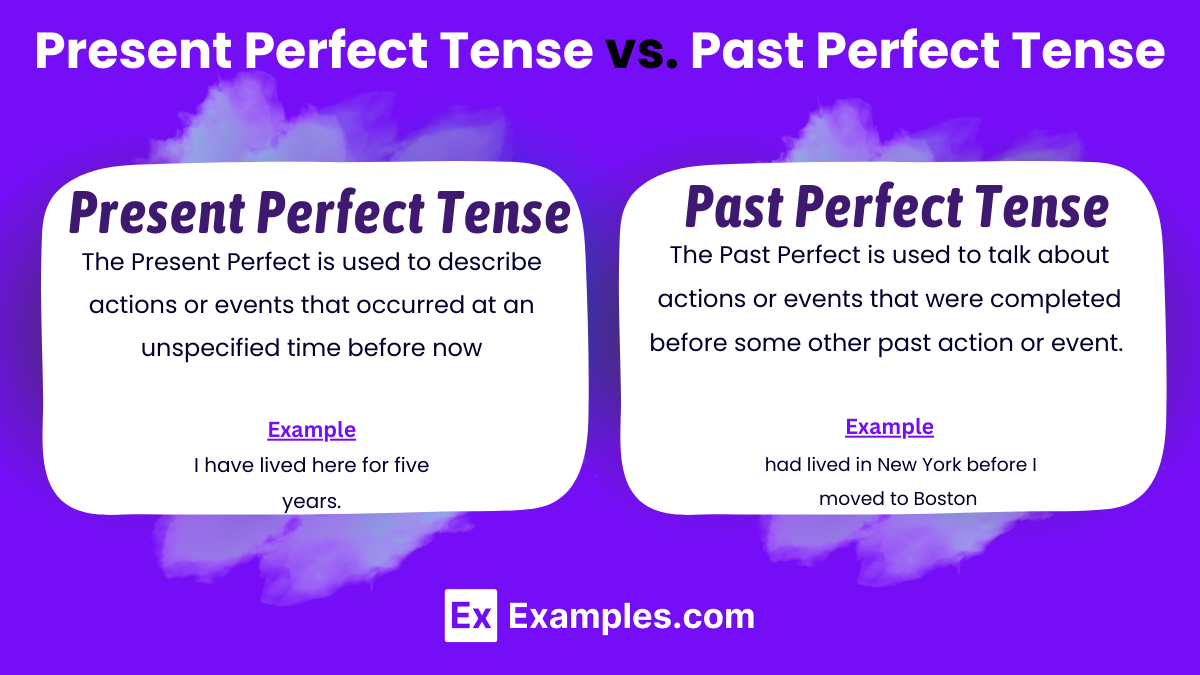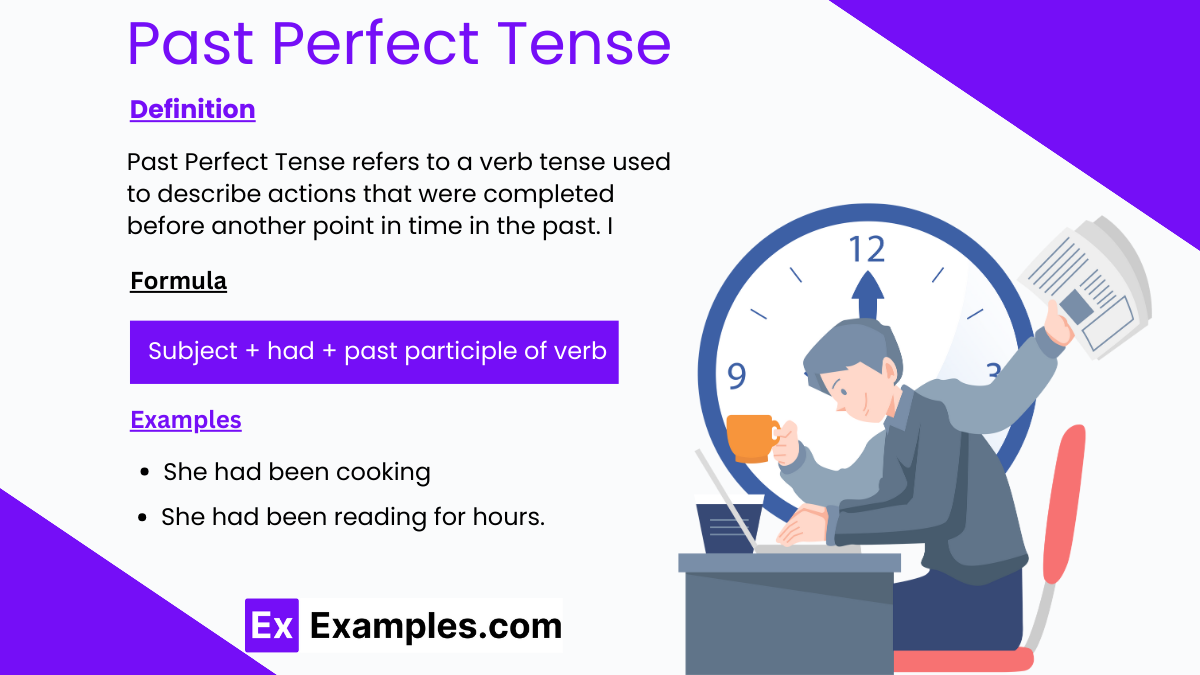10+ Past Perfect Tense Examples
Past Perfect Tense is used to describe actions that were completed before another action in the past. It is formed with ‘had’ followed by the past participle of the verb. Commonly used in reported speech, conditional sentences, and to express the order of past events.
What is Past Perfect Tense?
Past Perfect Tense refers to a verb tense used to describe actions that were completed before another point in time in the past. It is formed by using the auxiliary verb “had” followed by the past participle of the main verb. This tense is often used to emphasize that one action was completed before another in the past, making it common in storytelling and complex narratives to highlight sequences or causality of events.
For example:
- By the time she called, I had finished the project.
- They had left the stadium before the rain started.
The Past Perfect Tense is particularly useful in reported speech, conditional statements, and to express contrast between earlier and later past events.
Formula of Past Perfect Tense
Past Perfect Tense Rules
Formation
Always use the auxiliary verb “had” with the past participle of the main verb, regardless of the subject. For example:
They had arrived before the meeting started.
She had written the letter by then.
Timing of Events
Use the Past Perfect to show that one action was completed before another in the past. The past perfect action is the earlier action.
I had finished my meal when he called.
Conditional Sentences
It is often used in the if-clause of third conditional sentences to talk about conditions in the past that did not happen.
If I had known you were in town, I would have called.
Reported Speech
When reporting speech, the tense often changes back to the past perfect if the original speech was in the simple past.
He said he had seen a movie.
Duration Before Something in the Past
To show that something started in the past and continued up to another action in the past, use the past perfect.
We had been friends for years before we became business partners.
Past Conditions
Used to describe a past state or situation that no longer exists.
He was tired because he had been working all night.
No Sequence with Past Simple
Do not use the past perfect when the sequence of events is clear and one action follows immediately after another.
Incorrect: After I had eaten, I had washed the dishes.
Correct: After I had eaten, I washed the dishes.
How to use the Past Perfect Tense
The Past Perfect Tense is primarily used to express that an action or condition was completed before another past event occurred. It is constructed with the auxiliary verb “had” followed by the past participle of the main verb. This tense is especially useful in narratives to establish a timeline of events, showing which actions happened first. For example, in the sentence “She had already left when I arrived,” the past perfect tense (‘had left’) indicates that her departure occurred before the point in time of arrival. It’s also crucial in reported speech and conditional sentences to reflect past possibilities or hypotheticals, such as in the sentence, “If I had known, I would have acted differently.”
When employing the Past Perfect Tense, it’s important to ensure that there is a clear reference to a later event in the past, as the tense aims to highlight the sequence of events or prior conditions influencing subsequent actions. For instance, in storytelling, you might say, “The ground was wet because it had rained the previous night,” using the past perfect (‘had rained’) to explain the reason for the ground’s condition at a later time. This tense is also used to describe durations up to a point in the past, as in, “By the time he moved to New York, he had been working for the company for over ten years,” indicating an action that began and continued until another past action occurred.
Uses of past perfect tense
- To Indicate Completed Actions Before Another Past Event: The most common use of the past perfect is to show that one action was completed before another took place in the past. For example, “He had finished his meal before we arrived.”
- To Describe Conditions Existing Before a Specific Time: This tense can describe a condition or state that existed before a certain point in the past. It’s useful for setting scenes in narratives or explaining circumstances, as in, “She felt relaxed because she had completed all her exams.”
- In Reported Speech: When reporting what someone said, thought, or felt in the past, the past perfect is used to shift the tense back further from the simple past. For instance, “She said that she had never been to Paris.”
- In Third Conditional Sentences: It’s used in the ‘if’ clause of third conditional sentences, which refer to past situations that did not happen or were contrary to what actually occurred. An example is, “If I had known you were coming, I would have baked a cake.”
- To Show Cause and Effect in the Past: The past perfect can also indicate the cause of a past event. By using it, you can specify why something happened in a narrative, like in, “They were tired because they had been hiking all day.”
- For Duration Up to Another Point in the Past: When discussing an action that continued up to another past action, the past perfect tense helps emphasize the duration, as in, “By the time the police arrived, the thief had already fled.”
Examples of the Past Perfect Tense
The Past Perfect Tense is used to emphasize that an action was completed before another action in the past. Here are ten examples to illustrate its usage:
- She had left the house by the time I woke up.
- They had finished their homework before the movie started.
- I had completed the report before the deadline.
- We had started dinner when they called to cancel.
- He had written three books by the age of twenty-five.
- They had been married for ten years before they moved to Canada.
- I had never seen such a beautiful sunset before that day.
- She had studied Spanish before she visited Argentina.
- We had just put the baby down when the phone rang.
- He had worked at the company for thirty years before he retired.
Differences between Present Perfect Tense and Past Perfect Tense

Present Perfect Tense
- Usage: The Present Perfect is used to describe actions or events that occurred at an unspecified time before now. It emphasizes the relevance or results of these actions in the present.
- Formation: It is formed using the auxiliary verb “have” (or “has” for third person singular) plus the past participle of the main verb. For example: “She has visited Paris.”
- Time Reference: This tense often suggests that the action isn’t limited to the past; it might continue into the present or could happen again in the future. Phrases like “ever,” “never,” “already,” and “just” are commonly used.
- Examples:
- I have lived here for five years. (The person still lives there.)
- They have finished their meal. (The meal is finished now.)
Past Perfect Tense
- Usage: The Past Perfect is used to talk about actions or events that were completed before some other past action or event. It focuses on showing which past event happened first.
- Formation: It is formed using the auxiliary verb “had” plus the past participle of the main verb. For example: “She had visited Paris.”
- Time Reference: This tense is always linked to a past time and is used to make clear that one past event occurred before another. It’s particularly useful in storytelling to establish the order of events.
- Examples:
- I had lived in New York before I moved to Boston. (The living in New York occurred before moving to Boston.)
- They had finished their meal when we arrived. (Their finishing the meal occurred before our arrival.)
FAQ’s
Is Past Perfect Tense common in spoken English?
It’s less common in casual conversation but used in formal, narrative, or written English.
How does Past Perfect Tense differ from Simple Past?
It indicates a past action occurred before another, whereas Simple Past only denotes a past action.
Can Past Perfect Tense be used with time expressions?
Yes, often with expressions like “before,” “by the time,” and “until.”
What are examples of Past Perfect Tense verbs?
Examples include “had gone,” “had seen,” “had finished.”
How is Past Perfect Tense used in conditional sentences?
It’s used in the ‘if’ clause of third conditional sentences for hypothetical past situations.



